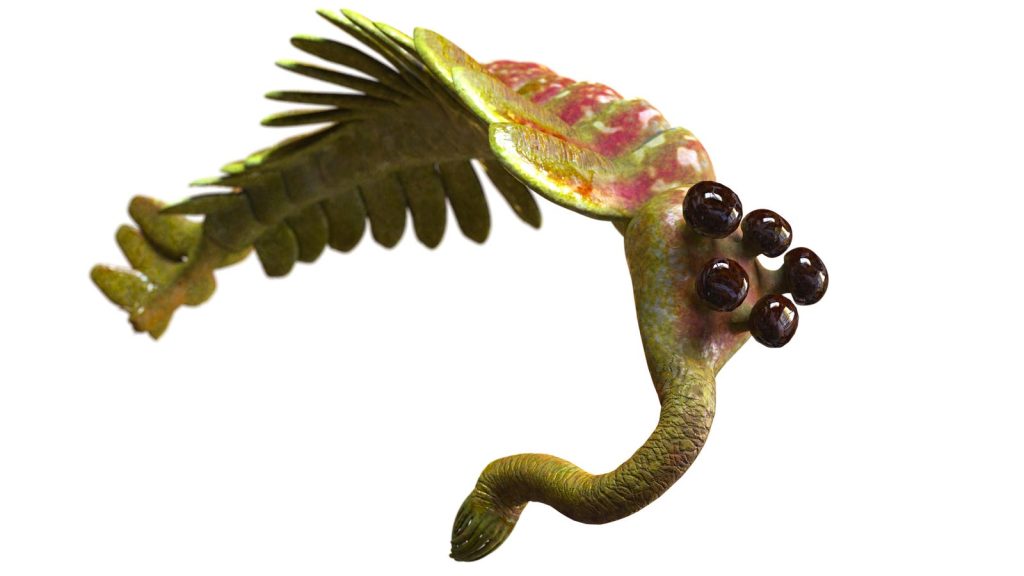The Canadian Rockies are a candy store for paleontologists—myriad perfectly preserved fossils continue to be unearthed in the Burgess Shale deposits. Among these were the fossils of a curious creature discovered in 2019 that had an unusual spaceship-like exoskeleton. This earned it the nickname “Millennium Falcon,” a nod to the Star Wars spaceship that inspired the species’ name.
It was a discovery that highlights the incredible diversity of life half a billion years ago, among the ancestors of modern-day arthropods. This four-inch-long creature was Cambroraster falcatus, the primordial ocean-dwelling ancestor of spiders, crabs and even insects. With its flattened, oval shape and distinctive armored exoskeleton, it resembled a small tank cruising the ocean floor, and whipping up sand along the way.
The fossil of a similarly shaped, larger creature was also found in the same landscape—Titanokorys gainesi, which was far bigger at 19 inches long. They both looked a little like the horseshoe crab, which, not surprisingly, descended from these creatures.
Though their sizes may not impress you today, Cambroraster and Titanokorys thrived in a time when multicellular life was just beginning to flourish—most organisms being no larger than an adult human pinkie. This period was known as the Cambrian explosion. The products of the explosion eventually evolved into the arthropods that now dominate terrestrial and aquatic ecosystems across the world.
Spaceships In The Ancient Seas
Cambroraster and Titanokorys are remnants of the Cambrian period 500 million years ago, when the Earth was a very different place.
There was one enormous ocean, and it was just beginning to teem with otherworldly life. Oxygen began filling up the atmosphere in copious amounts, allowing life an opportunity to rapidly advance from simple microbes to complex, fascinating creatures in the Cambrian explosion.
Both creatures were radiodonts, early arthropods that featured Swiss Army knife-like appendages near the head. These were likely used for locomotion and for sifting through ocean sediment for smaller food items, much like many of today’s crustaceans.
Over the millennia, these appendages evolved into specialized limbs seen in modern crustaceans and arachnids. They also had teeth and mouths reminiscent of the fictional sandworms from the Dune saga (see image above).
Though they looked alike, Titanokorys had a huge head compared to its body, an evolutionary strategy to compete with the abundance of marine predators at the time. Long before vertebrates had even started evolving, these marine predators had already developed complex anatomical strategies for survival.
Their compound eyes were likely capable of detecting changes in light within the murky depths. The position of the eyes also hints at a capability for near 360-degree vision, a useful adaptation for avoiding predators.
3 Other Bizarre Products Of The Cambrian Explosion
The reason why the Burgess Shale region of Mount Wapta is so fossil-rich is that it was once part of an underwater slope where mudslides buried organisms quickly, preserving even soft tissues in extraordinary detail.
These conditions created a unique snapshot of Cambrian life, revealing the strange and diverse creatures that flourished during this evolutionary explosion.
For instance, scientists who first spotted Hallucigenia probably did a double take.
Its head is nearly indistinguishable from its tail, and the seven to eight spindly legs attached to the worm-like body almost mirror the spikes alternating on its back. It is thought to be an early ancestor of velvet worms of today.
Then, Opabinia was the stuff of sci-fi movies, as the features of this ocean dweller seems like an abstract dream.
It had five eyes on stalks, a protruding appendage with crab-like claws at the end (probably to grab prey) and a backwards-facing mouth. Its soft body looked like a segmented trunk. Though it looks nothing like modern arthropods, crustaceans or insects, it is considered to be an early ancestor of these groups, and challenges what we know about their evolution.
The fossil of Tamiscolaris, discovered in Greenland in 2014, measured approximately a foot in length.
Another one of Earth’s earliest filter feeders, these creatures had fine bristles to comb out microorganisms from seawater, showcasing an efficient adaptation for survival in ancient oceans.
Landscapes that hold fragile fossils like the Cambroraster are rapidly degrading thanks to climate change, along with the knowledge they offer. How anxious are you about climate change? Take this test to find out: Climate Change Worry Scale
Read the full article here






